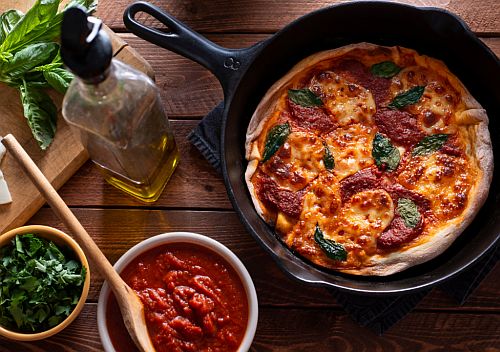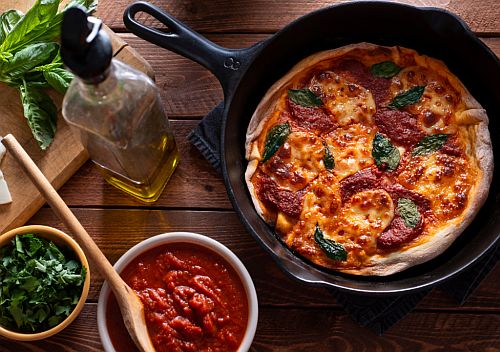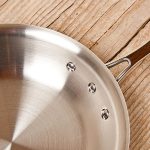Cast iron cookware is very durable and can last for generations if cared for properly. Cast iron is an ideal metal for baking food. The exceptional ability to retain heat is what sets this cookware material apart. Some chefs believe that cast iron is the best choice for making a delicious pizza with a golden brown crust and a chewy interior. Let’s analyze why many people choose a cast iron pan to make homemade pizza.
1. Ergonomics
To bake pizza in a cast iron pan, you don’t need any equipment other than heat-resistant gloves. The handle gives you control and makes an iron pan much easier to use than a traditional pizza stone. When the pizza is ready to serve, you can easily slide oven mitts underneath it. The pan handles are especially useful if you want to rotate your pizza to heat it evenly during the cooking process or if you need to add more toppings while the pizza is baking.
Traditional pizza stones don’t have handles and it can be tricky to put the pizza in and take it out of the oven. You must protect your hands and use additional equipment when moving the pizza from the stone.
The lip helps keep the dough and all ingredients in the pan and prevents cheese and juice from splattering onto the bottom of your oven. This also prevents cheese and other ingredients from burning at the bottom of the oven and creating smoke.

2. Easy Preheating
It takes longer for an oven with a stone to reach the required temperature than for a cast-iron skillet. The stone absorbs heat and slows down the heating. To cook your pizza using a stone, put the stone in the oven and preheat the oven to 500 F for at least 30 minutes. You should never place a cold stone into a hot oven since the thermal shock will cause it to crack.
A cast iron skillet won’t break if you put it in a hot oven. However, for best results, it is recommended to preheat the cast iron before pouring the ingredients into it. Cast iron takes some time to distribute heat evenly, but once it reaches the desired temperature, it stays hot for a while. Placing the pizza in a thoroughly preheated cast iron pan will ensure that your pizza is cooked evenly and you can easily remove it from the pan.
Additionally, pizza takes longer to bake with a stone than in a cast iron pan. An iron pan shortens the cooking process by 1-2 minutes compared to baking on a pizza stone.

3. Strength and Durability
A cast iron skillet is virtually indestructible and can last for decades if cared for properly. The non-stick effect improves over time. Cast iron can be used at any temperature and will not crack when exposed to sudden temperature changes. It won’t break if you accidentally drop it on the hard floor. You can safely place the cold dough or frozen pizza in a hot cast iron pan, while you should avoid placing cold food on a hot pizza stone.
Pizza stones cannot tolerate sudden temperature changes. They often break due to thermal shock or when dropped. You need to place the stone in the oven while the oven is cold or leave it in the oven the entire time. You should wait until the stone cools completely before removing the pizza from the oven. If liquid ingredients in the covering fall onto the stone, temperature fluctuations can occur, causing small cracks that can later lead to breakage.
4. Versatility
The cast-iron pizza pan is much more versatile than a pizza stone. It can be used with almost any heat source, including a stovetop, BBQ grill, in the oven, under the broiler, and over a campfire. It can also serve as a grill plate for cooking various meals.
You can cook hundreds of different foods in a cast-iron skillet. It is great for making eggs and bacon, roasted vegetables, breakfast pancakes, crepes, cookies, biscuits, rolls, breaded fish fillets, and much more.
5. High Performances
After preheating, the cast iron pan heats evenly and retains heat well, ensuring a constant temperature. This ensures that your pizza cooks evenly and without hot spots. Your pizza should be cooked through, with no uncooked pieces or burnt crust.
The cast-iron pan remains hot even when you remove it from the oven. The crust will continue to cook for several minutes, while the topping won’t get burnt. The pizza stays warm for a long time after cooking.
Is a Cast Iron Pizza Pan Worth Buying?
All materials used to make pizza have their advantages and disadvantages. Pizza stones have improved over time and are more durable than they once were. Many people prefer the taste and crust of brick oven pizzas. There are also stones with an improved ergonomic design, such as additional handles. Stainless steel pizza pans also have their advantages, such as high durability and extremely easy maintenance.
This post contains links to Amazon. The publisher may get paid if You purchase something through the links without additional costs to You.
Buyers choose cookware for baking pizza based on their personal preferences. If you prefer cast iron over other cookware materials, you might want to consider the Lodge BOLD 14-inch Seasoned Cast Iron Pizza Pan. This pan has met the expectations of many satisfied customers and is highly recommended by users for making delicious homemade pizzas.




There really are a surprising number of benefits that you can get from cast iron pizza pans. As the article points out, one of them is that they can be used to cook more than just pizza. After all, because of how conductive cast iron is, it can be used for anything from grilling to stovetop cooking.